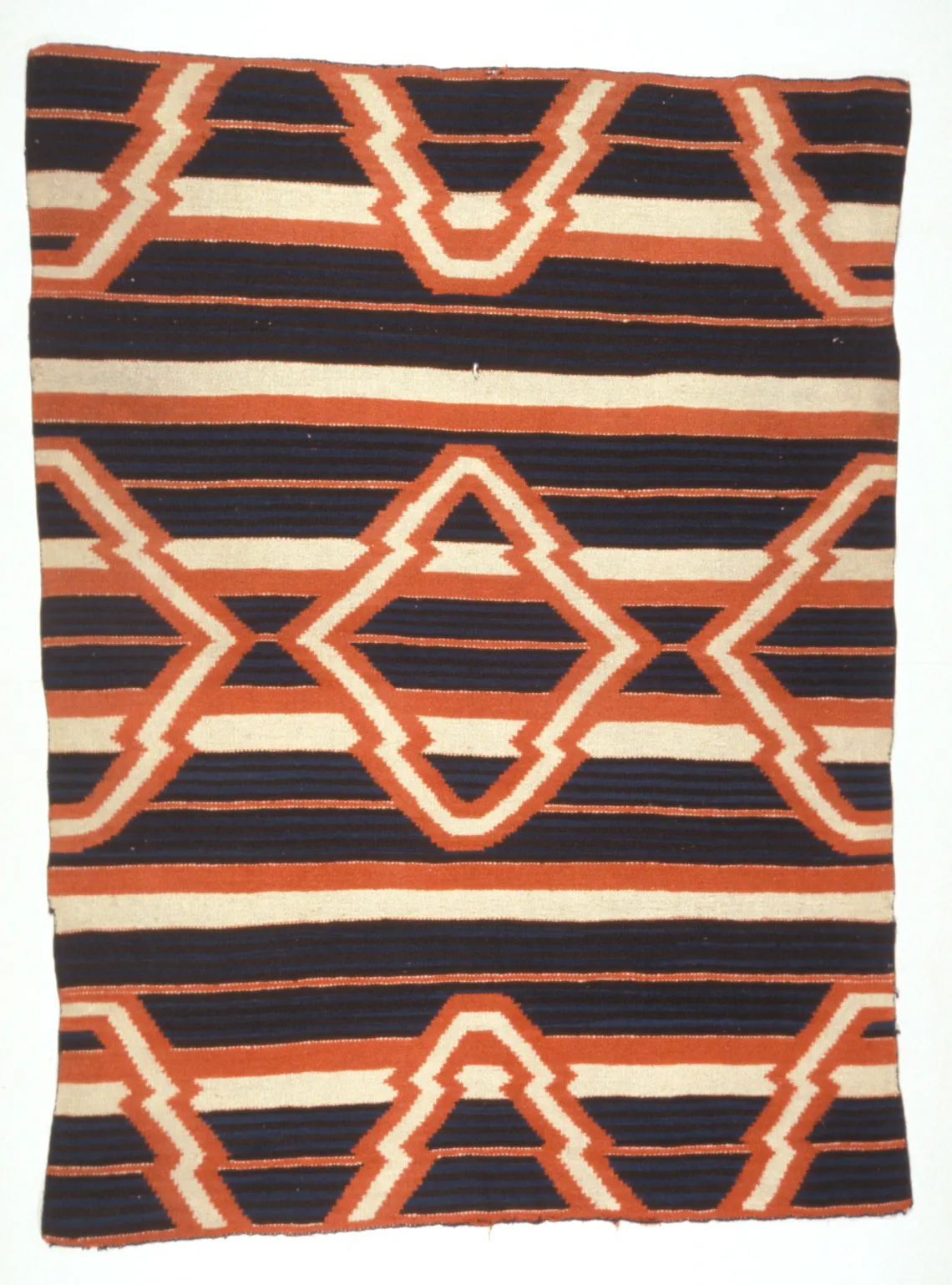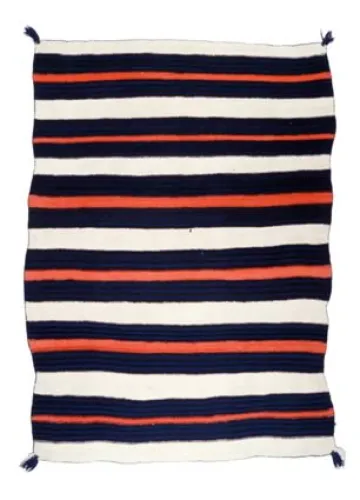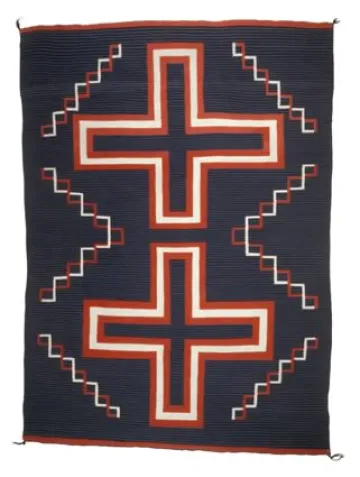
Banded Navajo blankets from the nineteenth century closely resemble Pueblo antecedents. They are woven longer-than-wide, with varied rhythms of striping and color combinations. One common banded style is the so-called Moqui stripe, named with an alternative (and archaic) term for the Hopi Indians. Curiously, little evidence shows Hopis (Moquis) actually weaving or wearing this style, although it was a standard Spanish-American blanket pattern as well as one popular in the Pueblos of New Mexico.
This style used zones of repeated narrow blue and brown-black banding as its basis. These zones might alternate with plain white or other colored bands. In later versions, weavers superimposed bold red triangles, diamonds, and other motifs on the banded “background.”
Above:
Moqui striped blanket
ca. 1880-18885
Tapestry weave, interlocked joins
1.285 x 1.715 m
67.52 x 50.591 in.
Catalog No. 22080
Collected by General John Logan
Donated by his grandson in 1937
“A lot of the old-time weavers unraveled the Rio Grande rugs or sarapes and then rewove them Navajo style. People preferred Navajo blankets to Mexican or Hispanic sarapes, because the Navajo weaving was much tighter and heavier. Some patterns like this probably came from Rio Grande sarapes.” —Barbara Ornelas
“This is like a kid on school picture-taking day—all shiny and bright, spit and polish. The background is busy, having the diamonds ‘clean’ keeps you from feeling overwhelmed.” —Sierra Ornelas
“This weaver was comfortable and knew what she was doing with her patterns. There’s a general flow. It’s bold, but also seems calm to me. The weaving was done in peace and harmony.” —Barbara Ornelas
“The weaver unraveled and rewove a rough-textured commercial American flannel. She used a serrate diamond pattern common in the Rio Grande area of New Mexico.” — Ann Hedlund
| Function | Fiber | Type | Ply-Spin-Twist | Color | Dye | Count * | ||
|---|---|---|---|---|---|---|---|---|
| Warp | Wool | Handspun | -- | Z | -- | White | None | 9 |
| Warp | Wool | Handspun | -- | Z | -- | Dk Brown | None | 9 |
| Weft | Wool | Handspun | -- | Z | -- | Black | None Blk+Native | 35 |
| Weft | Wool | Handspun | -- | Z | -- | Blue | Indigo | 35 |
| Weft | Wool | Handspun | -- | Z | -- | White | None | 35 |
| Weft | Wool | Raveled | -- | Z | -- | Orange-Red | Synthetic, Tested 2004 | 46 |
| Ecord | Wool | Handspun | 3 | z | S | Blue | Indigo | 2 |
| * threads/inch | ||||||||
| Function | Fiber | Type | Ply-Spin-Twist | Color | Dye | Count * | ||
|---|---|---|---|---|---|---|---|---|
| Warp | Wool | Handspun | -- | Z | -- | White | None | 8 |
| Weft | Wool | Handspun | -- | Z | -- | Lt Orange-Red | Synthetic | 20 |
| Weft | Wool | Handspun | -- | Z | -- | White | None | 25 |
| Weft | Wool | Handspun | -- | Z | -- | Black | None Blk+Native | 28 |
| Weft | Wool | Handspun | -- | Z | -- | Blue | Indigo | 30 |
| Ecord | Wool | Handspun | 3 | z | S | Blue | Indigo | 2 |
| * threads/inch | ||||||||
“I get ‘pharmacy feelings’ about this piece [Michael’s father David is a pharmacist]. The ‘snakes’ along the sides are like those encircling the medical symbol—a caduceus.” —Michael Ornelas
| Function | Fiber | Type | Ply-Spin-Twist | Color | Dye | Count * | ||
|---|---|---|---|---|---|---|---|---|
| Warp | Wool | Handspun | -- | Z | -- | White | None | 9 |
| Weft | Wool | Germantown | 4 | z | S | Red | Synthetic | 56 |
| Weft | Wool | Germantown | 4 | z | S | Black | Synthetic | 56 |
| Weft | Wool | Germantown | 4 | z | S | Dk Blue | Synthetic | 56 |
| Weft | Wool | Germantown | 4 | z | S | White | None | 56 |
| Ecord | Wool | Germantown | 3(4 | z | S)Z | Black | Synthetic | 2 |
| * threads/inch | ||||||||







